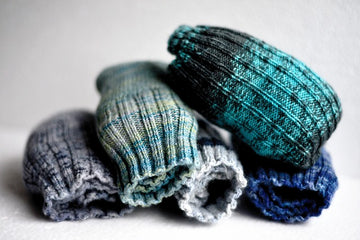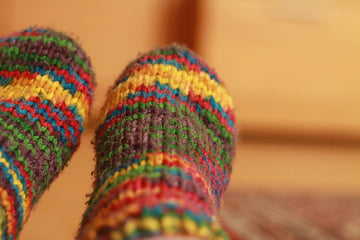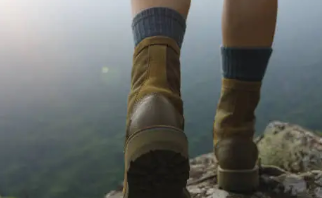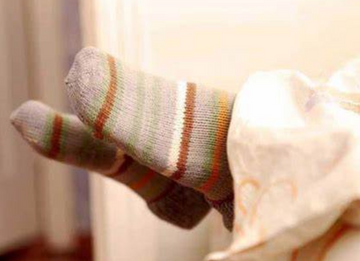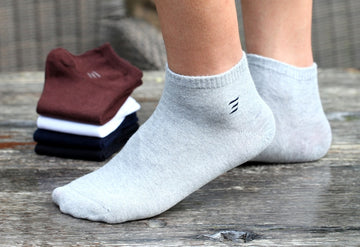
Ankle socks, a wardrobe staple for many, are more than just a simple piece of clothing. They offer a blend of comfort, practicality, and style that makes them a versatile choice for a variety of activities. Whether you're hitting the gym, running errands, or simply lounging around the house, ankle socks can provide the perfect balance of foot protection and breathability.
This guide will delve into the world of ankle socks, exploring their different types, functions, and benefits. We'll answer common questions like "What are ankle socks called?" and "How do I choose the right pair?" By the end, you'll be an ankle sock expert, ready to select the perfect pair for your needs.
What Are Ankle Socks Called
Ankle socks are also known as Ankle High Socks or Ankle Length Socks. As the name would suggest, ankle socks are socks that come up to your ankles. However, the length of ankle socks can still differ slightly.
What Are Low Cut Ankle Socks
Most ankle socks are low-cut and will sit just under your malleoli, the bony protrusions on either side of your ankle. These socks typically rise just above the heel and below the ankle bone, making them ideal for a minimal look and for wearing with low-top shoes or sneakers.
What Are Above Ankle Socks Called
But, you also get some ankle socks that sit above your malleoli. These are often referred to as quarter ankle socks. Quarter ankle socks rise slightly higher, covering the ankle bones and sometimes extending up to just above the ankle. Despite this difference, they are still classified as ankle socks.
Read More:
Anything longer than quarter ankle socks falls into the category of crew socks. Crew socks generally extend several inches above the ankle, often reaching the mid-calf. They are a very trendy type of sock around the world, just like ankle socks, and are popular for their versatility and comfort.
Read More:
In summary, ankle socks can vary in length but typically fall into two main categories: standard ankle socks that sit below the malleoli and quarter ankle socks that sit above the malleoli. Socks extending beyond this length are classified as crew socks.
What Are Ankle Compression Socks Good for
Ankle compression socks are good for a few things, mainly related to improving circulation and reducing discomfort in your feet and ankles.
- Improved blood circulation: By applying gentle pressure, they can help squeeze blood back up towards your heart, which is especially helpful if you're on your feet all day or sit for long periods [e.g. on airplanes]
- Reduced swelling: Compression can help reduce fluid buildup in your ankles and feet, which can cause achiness and tightness.
- Pain relief: Improved circulation and reduced swelling can lead to less pain and discomfort in your feet and ankles.
- Faster recovery: Some people wear them to help their feet and ankles recover after exercise or injury.
What Is the Point of Ankle Socks?
- Comfort: They provide a layer of fabric between your shoe and your foot, which can help absorb sweat and prevent blisters.
- Foot protection: They can help protect your feet from minor cuts and scrapes.
- Style: They can be a stylish choice, especially with low-top shoes or sneakers. They come in a wide variety of colors, patterns, and thicknesses to suit your taste.
- Temperature regulation: Because they don't cover your entire calf, they're a good option for warmer weather.
When Should You Wear Ankle Socks?
Ankle socks are a versatile choice for your feet, but here's a breakdown of when they shine.
With low-cut shoes: This is their natural habitat! Ankle socks pair perfectly with sneakers, loafers, boat shoes, and any other shoe where you don't want the sock to be visible.
For warmer weather: Since they allow for more breathability than crew socks, they're ideal for keeping your feet cool in hot weather.
During physical activities: Athletic ankle socks provide support and cushioning for workouts, running, or any activity where your feet need freedom of movement.
For casual wear: Ankle socks are a great go-to for everyday casual outfits. They offer comfort and a clean look.
Where Ankle Socks Might Not Be the Best ChoiceFormal occasions: Traditionally, with dress shoes for formal events, crew socks are preferred to ensure no sock shows when you sit or cross your legs.
Cold weather: For warmth, crew socks or even knee-high socks are better options for colder climates.
If you need arch support: Some crew socks offer arch support, which might be beneficial for people who need extra foot stability.
What Is the Difference Between Ankle and No Show Socks?
Ankle Socks
Coverage: Ankle socks cover the entire foot and extend up to the ankle. They provide full coverage of the heel, arch, and forefoot, reaching just above the ankle bone.
Visibility: Ankle socks are generally visible when worn with most types of shoes, including low-cut shoes like sneakers and casual shoes. They peek out above the shoe line, providing a low-profile look without being entirely hidden.
Use Cases: Ideal for athletic activities, casual wear, and everyday use. They offer a balance of comfort, protection, and style, making them suitable for a wide range of activities.
Support and Protection: Ankle socks offer better protection against friction and blisters as they cover more of the foot and ankle. They also provide additional support to the ankle area.
No-Show Socks
Coverage: No-show socks, as the name suggests, are designed to cover just the foot, staying below the ankle. They typically cover the toes, heel, and sole, but they sit much lower on the foot compared to ankle socks.
Visibility: No-show socks remain hidden or nearly invisible when worn with low-cut shoes such as loafers, boat shoes, ballet flats, or low-top sneakers. They are designed to provide the benefits of wearing socks without being seen.
Use Cases: Perfect for situations where you want the comfort and hygiene of socks without the visibility. They are commonly worn with dress shoes, casual slip-ons, or any footwear where a sockless appearance is desired.
Style: No-show socks are favored for their ability to maintain a clean and minimalist aesthetic. They are ideal for fashion-conscious individuals who want to avoid the look of visible socks.
Low Cut vs. No Show Socks - Everything You Need to Know
Coverage: Low cut socks sit just below the ankle bone, covering the heel and the lower part of the ankle. They provide slightly more coverage than no-show socks but less than ankle socks.
Visibility: While more discreet than ankle socks, low cut socks are still slightly visible above the shoe line. They are less visible than ankle socks but more so than no-show socks.
Use Cases: Suitable for casual and athletic wear where minimal visibility is preferred but some ankle coverage is still desired.
Key Differences: Ankle Socks vs. No-Show Socks
- Height and Coverage
Ankle Socks: Cover the entire foot up to the ankle bone.
No-Show Socks: Cover just the foot and stay below the ankle, remaining hidden when worn with most shoes.
- Visibility
Ankle Socks: Visible above the shoe line.
No-Show Socks: Hidden or nearly invisible when worn with low-cut shoes.
- Purpose and Use Cases
Ankle Socks: Ideal for a variety of activities including sports, casual outings, and everyday wear. They offer more protection and support.
No-Show Socks: Best for maintaining a sockless appearance while still providing comfort and hygiene. Perfect for dressier or more minimalist fashion choices.
- Protection and Support
Ankle Socks: Provide better protection against blisters and more support for the ankle area.
No-Show Socks: Offer minimal protection and support, focusing instead on staying hidden.
In conclusion, the choice between ankle socks and no-show socks depends on your needs for coverage, visibility, and use case. Ankle socks offer more protection and are suitable for a variety of activities, while no-show socks are perfect for achieving a sockless look with low-cut shoes.
Why Do Ankle Socks Fall Down?
Wrong size: If the socks are too loose, they won't hug your foot properly and can easily slide down into your shoe.
Wrong fabric: Socks made from slippery materials like silk or nylon may not have enough grip to stay up. Look for socks with a cotton blend or a silicone grip on the heel to prevent slipping.
Non-existent or worn-out grips: Some ankle socks, especially no-show socks, have silicone grips on the heel or sole to help them stay put. These grips can wear down over time, making the socks more prone to falling down.
Shoe type: Ankle socks might not be ideal for all shoe styles. If your shoes have a very loose heel cup, even a well-fitting sock might slip down.
How Do I Choose Ankle Socks?
Choosing the perfect ankle sock involves considering a few factors to ensure comfort, function, and style. Here's a breakdown to help you pick the right pair:
Fit
Size: This is crucial! Ill-fitting socks are the number one culprit for bunching, slipping, and discomfort. Opt for socks that hug your foot snugly without constricting your toes.
Heel: The heel cup of the sock should fit securely around your heel to prevent slippage.
Material
Cotton blend: A cotton blend offers breathability and comfort for everyday wear.
Synthetic materials: Socks with polyester or nylon can wick away moisture better, ideal for athletic activities.
Wool: Merino wool socks are great for colder weather as they provide warmth and good moisture management.
Thickness
Thin socks: Opt for thin, breathable socks for warmer weather or if you prefer a more minimalist feel.
Thicker socks: Choose thicker, cushioned socks for activities like running or for extra comfort during colder months.
Style
Crew length vs. Ankle: Ankle socks are ideal for low-cut shoes, while crew socks might be better for formal occasions or added warmth.
No-show socks: If you want a sockless look, choose no-show socks that sit below the ankle bone and stay hidden inside your shoes.
Color and pattern: Ankle socks come in a wide variety of colors and patterns. Choose plain socks for a classic look or patterned ones to add a touch of personality to your outfit.
Additional features
Silicone grips: Look for socks with silicone grips on the heel or sole for better grip and to prevent slipping.
Seamless toe: Seamless toes can prevent irritation for people who are sensitive to seams.
Final Words
Ankle socks are a must-have for any wardrobe. They offer a comfortable, stylish, and practical solution for keeping your feet happy. With a wide variety of lengths, materials, thicknesses, and styles available, there's an ankle sock out there for everyone. So next time you're putting together an outfit, consider the power of the humble ankle sock. They might just become your new favorite footwear companion.




